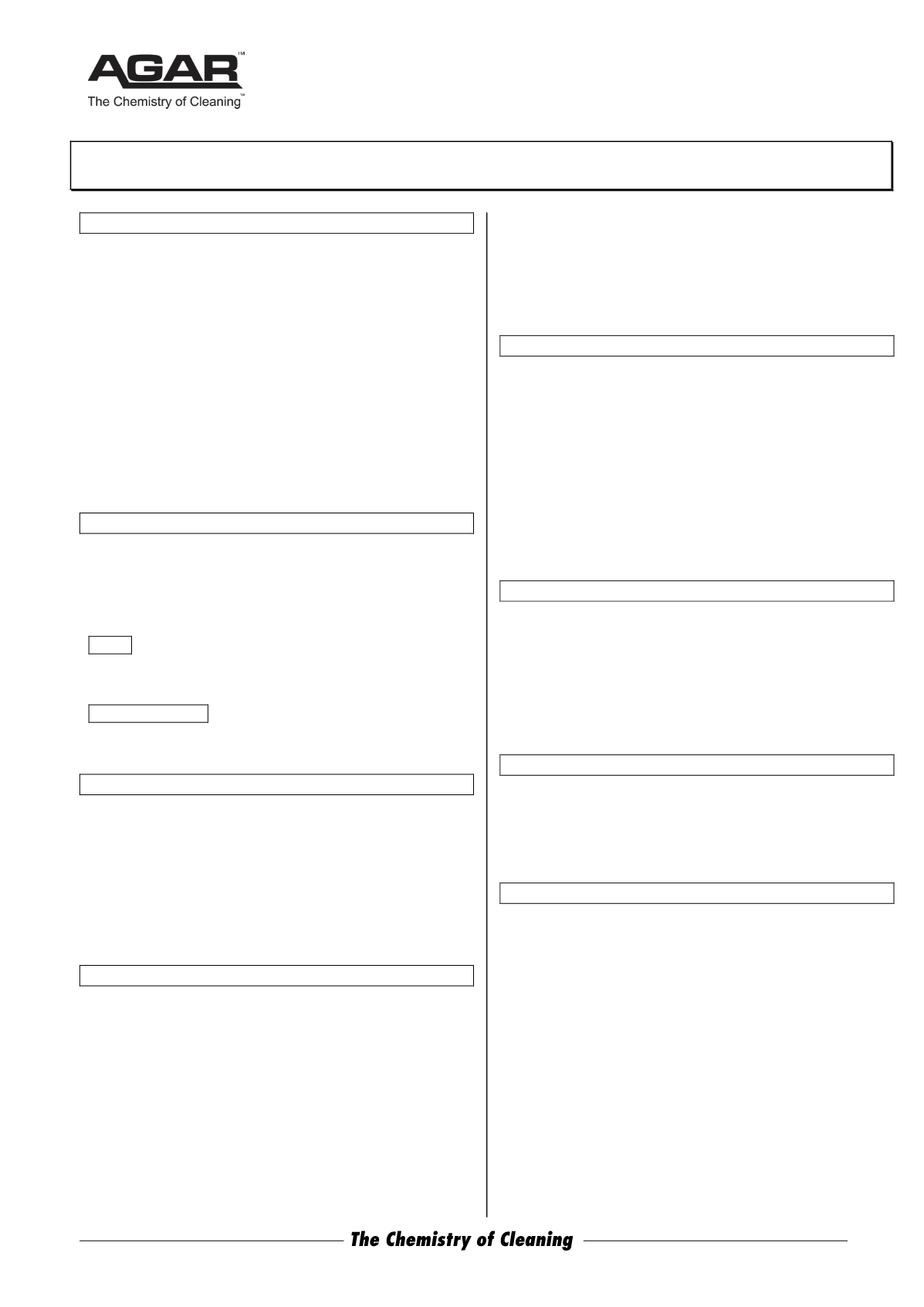

ABN 80 004 726 890 | MADE IN AUSTRALIA
VIC 03 9480 3000
NSW 02 9743 6020
SA 08 8293 2020
QLD 07 3274 3438
WA 08 9249 4566
Safety Data Sheet
Issued: November 30, 2012
Page 1 of 2
GRAFFITI WIPE-OFF
1 IDENTIFICATION OF THE MATERIAL AND SUPPLIER
Product Name:
GRAFFITI WIPE-OFF
Other Names: None
Manufacturer's Product Code: GRAD1, GRAD5
Product Use: Removal of paint and ink graffiti. Spray or brush
on, scrub and rinse off.
COMPANY DETAILS
Company: Agar Cleaning Systems Pty. Ltd.
Address: 12-14 Cope Street, Preston, Vic. 3072
Telephone: 03 9480 3000 Facsimile: 03 9480 5100
Web:
www.agar.com.auAgar SDS are available from this website.
E-mail:
sales@agar.com.auEmergency Telephone Number: 131 126
(Aust wide)
2 HAZARDS IDENTIFICATION
Hazardous according to criteria of SafeWork Australia.
HAZARDOUS SUBSTANCE. NON-DANGEROUS GOODS.
Irritant Xi
Risks:
Irritating to the eyes and skin.
Safety Directions:
Keep out of the reach of children.
3 COMPOSITION / INFORMATION ON INGREDIENTS
Ingredients:
Chemical Entity: CAS No.: Proportion:
Propylene carbonate
108-32-7 10-<30%
Propylene glycol n-butyl ether 5131-66-8 10-<30%
Dipropylene glycol
34590-94-8 10-<30%
mono-methyl ether
Methoxy propanol
107-98-2 <10%
Other ingredients determined to be
non-hazardous to 100%
4 FIRST AID MEASURES
Poisons Information Centre: Phone 131 126
Swallowed: If poisoning occurs, contact a doctor or Poisons
Information Centre. If swallowed, do NOT induce vomiting.
Give two glasses of water and seek medical help. Rinse
mouth with water. Never give anything by mouth to an
unconscious person.
Eye: Immediately hold the eyes open and wash continuously
for at least 10 minutes with fresh running water. Ensure
irrigation under eyelids by occasionally lifting the upper and
lower lids. Seek medical advice. Removal of contact lenses
after an eye injury should only be undertaken by skilled
personnel.
Skin: Remove any contaminated clothing and flush area with
water. Wash the skin thoroughly with soap and water. Seek
medical attention in the event of irritation.
Inhaled: Remove from the source of vapour, spray or fumes.
Remove patient to open space or fresh air, rest patient, keep
warm and seek medical advice. Give artificial respiration if
breathing stops.
5 FIRE FIGHTING MEASURES
Fire/Explosion Hazard: Graffiti Wipe-Off is combustible.
Fire Extinguishing Media: Water fog, fine water spray, foam or
dry agent. Carbon dioxide and sand.
Special Fire Fighting Procedures: Firefighters should use self -
contained breathing apparatus and protective gloves in case
of fire. In case of fire wear appropriate protection gear. In case
of fire, prevent by any means possible spillage from entering
drains or water courses. Use water spray to cool fire-exposed
containers.
Fire/Explosion/Decomposition Hazards: No unusual fire or
explosion hazards. When heated to decomposition, acrid
smoke and fumes as well as CO and CO2 are emitted.
6 ACCIDENTAL RELEASE MEASURES
Ventilate the spillage area thoroughly. Personnel involved in
clean-up require adequate skin, eye and respiratory protection.
Pump the liquid away and soak up the rest with an absorbent,
non-flammable material. Wash the contaminated area with
water and detergent. Prevent by any means possible spillage
from entering rivers or drains.
If spilled on clothing, remove and launder before re-use.
7 HANDLING AND STORAGE
Storage and Transport: -
Corrosivity Hazards: Not applicable.
Handling and storage Precautions: Keep the container tightly
closed. Store in a cool, well-ventilated , low-fire risk area.
Keep away from strong oxidising agents.
8 EXPOSURE CONTROLS / PERSONAL PROTECTION
Exposure Standards: None assigned for this mixture. However,
the following limits have been proposed:
Dipropylene glycol mono-methyl ether: TWA = 50 ppm (308
mg/cu.m) – ‘Skin’ i.e., absorption through the skin may be
possible
Methoxy propanol: TWA = 100 ppm (369 mg/cu.m)
STEL = 150 ppm (553mg/cu.m)
[Source: Safe WorkAustralia HSIS-2012]
Engineering Controls: General ventilation is recommended. If
mists and vapours are generated, especially in enclosed
areas, and natural ventilation is inadequate, a local exhaust
ventilation system is required.
Personal Protection:
Eyes - Wear safety glasses to prevent eye contact.
Gloves - Wear neoprene or nitrile gloves. PVC is not suitable.
Clothing - Wear protective clothing suitable for preventing
Please turn to page 2.


















